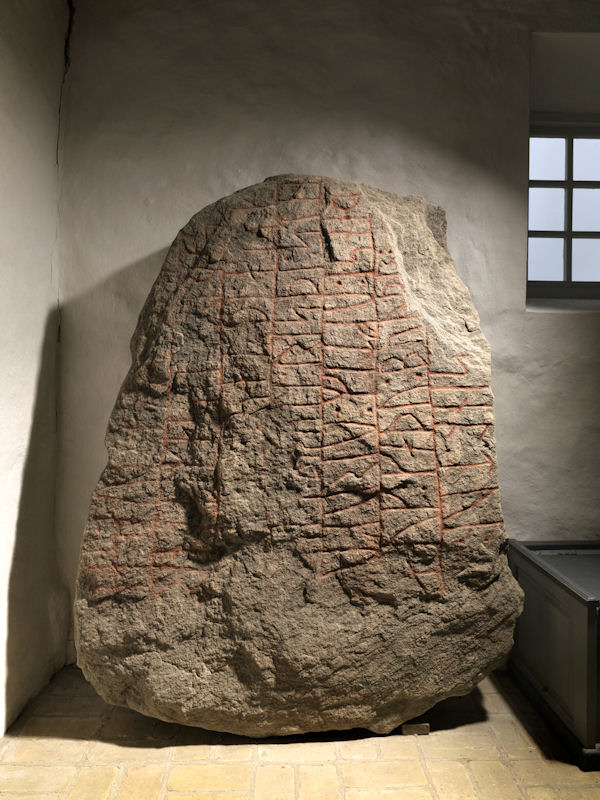Sønder Vinge Runestone 2 on:
[Wikipedia]
[Google]
[Amazon]
 The Sønder Vinge stone 2 or DR 83 is a
The Sønder Vinge stone 2 or DR 83 is a
accessed December 28, 2020. It is presently located in the porch of the church. It is probably from the period 970-1020 due to runic and linguistic features. It is 180 cm tall, 132 cm wide and 35 cm thick. Parts of the runic inscription have eroded which makes some runes hard to read. The style of the runestone is the runestone style RAK. The inscription ends with a curse similar to the ones found on the
- Rundata. : §Q (a)u(þ)(i) : bruti : risþi : stin ¶ : þensi : uftiʀ : uruku ¶ auk : kaþu : bruþr : ¶ sino : tuo : ¶ ... sarþi : auk ¶ siþ:riti : saʀ : monr : ¶ ias : auþi : mini : þui Old Norse transcription: : ' : ' English translation: : §P "Guði raised this stone in memory of Órókia and Kaða, his two brothers ... wounded and bewitched(?). A warlock(?) (be) the man who destroys this memorial!"
: §Q "Auði Steward raised this stone in memory of Órókia and Kaða, his two brothers. ay he be considereda pervert and a wizard(?), that man who destroys this memorial."
 The Sønder Vinge stone 2 or DR 83 is a
The Sønder Vinge stone 2 or DR 83 is a Viking Age
The Viking Age () was the period during the Middle Ages when Norsemen known as Vikings undertook large-scale raiding, colonizing, conquest, and trading throughout Europe and reached North America. It followed the Migration Period and the Germ ...
runestone
A runestone is typically a raised stone with a runic inscription, but the term can also be applied to inscriptions on boulders and on bedrock. The tradition began in the 4th century and lasted into the 12th century, but most of the runestones d ...
engraved in Old Norse
Old Norse, Old Nordic, or Old Scandinavian, is a stage of development of North Germanic dialects before their final divergence into separate Nordic languages. Old Norse was spoken by inhabitants of Scandinavia and their overseas settlemen ...
with the Younger Futhark
The Younger Futhark, also called Scandinavian runes, is a runic alphabet and a reduced form of the Elder Futhark, with only 16 characters, in use from about the 9th century, after a "transitional period" during the 7th and 8th centuries.
The ...
runic alphabet
Runes are the letters in a set of related alphabets known as runic alphabets native to the Germanic peoples. Runes were used to write various Germanic languages (with some exceptions) before they adopted the Latin alphabet, and for specialised ...
. The stone is in granite
Granite () is a coarse-grained ( phaneritic) intrusive igneous rock composed mostly of quartz, alkali feldspar, and plagioclase. It forms from magma with a high content of silica and alkali metal oxides that slowly cools and solidifies under ...
and was discovered in 1866 as a corner stone of Sønder Vinge Church, positioned with the runic inscription outwards.Danske Runeindskrifter, Nationalmuseetaccessed December 28, 2020. It is presently located in the porch of the church. It is probably from the period 970-1020 due to runic and linguistic features. It is 180 cm tall, 132 cm wide and 35 cm thick. Parts of the runic inscription have eroded which makes some runes hard to read. The style of the runestone is the runestone style RAK. The inscription ends with a curse similar to the ones found on the
Saleby Runestone
The Saleby Runestone, designated as Vg 67 in the Rundata catalog, was originally located in Saleby, Västra Götaland County, Sweden, which is in the historic province of Västergötland, and is one of the few runestones that is raised in memory ...
and Glemminge stone
The Glemminge stone or DR 338 is a Viking Age runestone engraved in Old Norse with the Younger Futhark runic alphabet. It is found in the wall of Glimminge church in Scania, in Ystad Municipality in Sweden. The style of the runestone is the runes ...
in Sweden, and on Tryggevælde and the Glavendrup runestones in Denmark
)
, song = ( en, "King Christian stood by the lofty mast")
, song_type = National and royal anthem
, image_map = EU-Denmark.svg
, map_caption =
, subdivision_type = Sovereign state
, subdivision_name = Kingdom of Denmark
, establish ...
. However, the interpretation of the curse as well as meaning of the word ''ræti'' ("warlock") are contested.
Inscription
: §P -u(þ)(i) : b(i)--(l)i : risþi : stin ¶ : þensi : uftiʀ : uruku ¶ auk : kaþu : bruþr : ¶ sino : tuo : ¶ ... sarþi : auk ¶ siþ : r(a)(t)i : saʀ : monr : ¶ ias : auþi : mini : þuiScandinavian Runic-text Database- Rundata. : §Q (a)u(þ)(i) : bruti : risþi : stin ¶ : þensi : uftiʀ : uruku ¶ auk : kaþu : bruþr : ¶ sino : tuo : ¶ ... sarþi : auk ¶ siþ:riti : saʀ : monr : ¶ ias : auþi : mini : þui Old Norse transcription: : ' : ' English translation: : §P "Guði
References
{{runestones Runestones in Denmark Runestones with curses 10th-century inscriptions 11th-century inscriptions